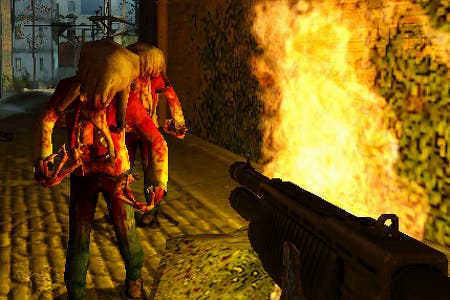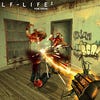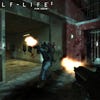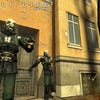Retrospective: Half-Life 2 Episodes 1 & 2
Rise and shine.
If there's one question Valve must be sick of hearing it's this: where is Episode 3? No-one's saying anything - not yet. But inquiring minds might find their own answers by playing through the preceding two episodes.
There are other burning questions, too: will the next release still be branded an episodic offshoot of Half-Life 2, or has it, as some fans have supposed, evolved into the grander form of Half-Life 3? Then there's the batch of recently leaked concept art, originating from 2008, prompting many to wonder whether the interdimensional Xen world will make a reappearance (possibly now reimagined as a tie-dye acid-trip featuring floating avioli and alien squid-flowers) and raising the pressing issue of what kind of ear-muffs Alyx will sport in the cold wastes as she hunts for The Borealis, an Aperture Science ship containing either humanity's salvation or its doom.
While these mysteries are no doubt intoxicating, the really important questions are the ones Valve will have been asking itself as Episode 3's development slipped further and further away from the release of its predecessor. How has the FPS genre changed? What will fans now expect and demand? Will a voiceless protagonist - little more than a floating gun in black-rimmed specs - still cut it in an era of richly realised character interactions and physically complete avatars? Will the sprawling worlds we regularly see in other games make gamers go green with envy as they bump into the barriers that funnel Gordon's journey? What does the next Half-Life installment need to change, perhaps even at a fundamental level, to be as pioneering and brilliant as those in its past?
Valve's search for those answers is no doubt well served by employing the biggest brains in the industry, but we can infer from the game's delay that it hasn't been easy. And the longer the game remains in development, the greater step-change is required. To see that this is so, you need only look at the last two episodes. The first was well-received, but playing it now you may wonder if its scores were a little buoyed by anticipation, and flaws overlooked out of a nostalgic acceptance of FPS traditions that, even at the time, were looking a little dog-eared.
Though developed concurrently, it pales in comparison to Valve's subsequent effort, not just in its volume of content, but in the sophistication of its dramatic construction, in its mechanical variety and technological potency. The stark difference between these two episodes not only marks the pace of change in the industry which Valve need to match, but also points to the directions in which the series continues to expand.
Episode One isn't a total wash-out by any means: its opening chapters in the Citadel are a delirious mix of grav-gun combat, otherworldly spectacle and neat, pacey puzzling. It sets up the narrative drive for the episode well: the immediate need to evacuate the city urgently reinforces the longer-term goal of delivering stolen Combine data to the rebellion. Judith's unexplained transmission establishes an even more distant narrative question, while the appearances of G-Man, Vortigaunts and the Combine Advisor draw out the complex interrelations of the factions at play behind the scenes. A closer view of the Stalkers also underscores the cold, grotesque malevolence of the regime you have brought down in the previous game, and Alyx's fear of them helps to make her a more emotionally vulnerable, and thus human, character.
(Incidentally, 'vulnerability' seems to have become a flashpoint term following the recent Tomb Raider spat - but in my mind, its main purpose is as a humanising trait and not an explicitly gendered one. Master Chief and Marcus Fenix may not be obviously vulnerable, but then they are boring, charmless characters who should hardly be aspirational templates for any hero or heroine striving for emotional credibility.)
In the Citadel, Valve shows itself at its best: it empowers the player with the game's most devastating tool - the super gravity gun - but puts you in positions where even its might is tested. A halting descent to the boiling core sees the player flit between solving energy-ball trick-shot puzzles to power light bridges and elevators, deflecting debris from the collapsing superstructure and ripping through the hordes of soldiers who still protect it.
Deprived of your arsenal of guns, it also emphasises Alyx's primacy in the episode - she is your main ranged defence against the incoming hordes. The core itself is a tour de-force of the Source tech and Valve's acute aesthetic sense for the uncanny - an ovular pulsating mass of strobing energy that's ominous, hot and entirely alien. That you see it from above, before winding your way down and around it, is a demonstration of Valve's brilliance with spatial interaction. It is this, above all things, that separates games from other media, and Valve knows how to explain a space fully and invite the player to explore it, all the while masterfully defining the pace and drama of that experience.
This also makes plain what is missing from the rest of the episode. After dealing with the Citadel, what follows is a trudge from one end of City 17 to the other, largely through underground car parks it seems, and then, later, through the anonymous, shattered remains of the streets. I remembered almost nothing of this sequence prior to playing it again, and the reasons for this lie in the game's failure to make your navigation comprehensible, either spatially or narratively.
The sequence underground is claustrophobic without respite, and its sequence of rooms provides you with no overview of the challenges before you, or the eventual goal. They are simply rooms, and you have no choice but to leave each by the only exit available to you without even the illusion of of self-direction. For all you know, barrelling through this blind, subterranean world might take you back towards the Citadel. Above ground, the remains of City 17 offer little coherence or identity, and your onwards march is governed not by any clear geographical motivation (illusory or otherwise) but by the trammels laid down by the game's designers.
In the subterranean confines, the battles with zombies and antlions - both mindless swarm creatures - prove wearying. The addition of the self-detonating zombine makes for a nice panicky twist, and adds to your tactical repertoire, but it is perhaps not evolution enough. The various puzzles you encounter, meanwhile, often involve you turning a valve very slowly, with any interruption causing it to spin back the whole way.
It's also here that a certain laboriousness to selecting your arsenal becomes apparent, and its something that Valve might well consider redressing in any future game. Antlion burrows need to be filled, using the gravity gun to slowly shove car wrecks into the holes, but this can't be achieved with any other weapon in hand. You are reliant on knocking antlions over with the gravity gun and hoping Alyx does the rest - a disempowering result that either reduces the player to the role of fragile helper or forces constant fiddling with inventory.
The point of all this isn't that Episode One is a poor game (few games do hold up to Valve's standards) but that its apparent flaws are so diligently addressed in its sequel. The strictures of antlion combat are inverted. Your venture into their burrows sees you encounter the flighty, cautious antlion workers, whose ranged bombardment and aggressive repositioning makes for a thrilling tactical contrast with the direct attacks of the hive's soldiers. More importantly, your companion here, a vortigaunt, takes on the role you had in the previous episode, stunning and upturning attackers - so gifting you the primary role of finishing them off. He also has a hilarious line in bathetic overstatement.
Even in these underground lairs, Valve shows it has understood the problems of the previous episode's subterranean section. Try and snatch some goodies from a mine-cart and it trundles off into an abyss, leading your eye across a cavernous hollow and to your eventual goal, once again explaining the space you will later explore. You see this trick being used time and again throughout the episode, and it not only places your journey in a clear geographical context but it also has the effect of making each environment seem much larger and filled with tangible, interactive interest.
Buildings on the horizon are no longer relegated to skybox prettiness - they are places you have been or are going to. The deserted factory where Alyx has her first fateful encounter with a Hunter is glimpsed from an earlier outbuilding, your path to it winding round and down a mineshaft. Then there's the precipitous descent through a zombie infested plant, as Alyx's sniper beam draws a line, constantly re-establishing your relative positions within the space. You scale the other side of the valley and leap back in a car across a seesawing bridge - a grandiose revision of Half-Life 2's first ever counterweight puzzle, and a statement of progress and intent with the game's physics simulation.
Of course, all of these environments really are bigger than their counterparts in earlier installments of the series, but Valve wrings every square foot from them, spicing the drive to White Forest with optional diversions. That the game allows free-form exploration here while maintaining such an elegantly controlled sense of pace and drama is really what sets the developer apart from its peers.
The cluster of buildings which allows Alyx her revenge upon the Hunters has been constructed to guide the player around up, down and through a building jammed with dramatic triggers, but not before you've been tempted to explore the other outlying structures, which draw your eye with their brighter shades of paint. The White Forest Inn, to my mind, is the setting of the finest battle to be had in any game: there's the agonising wait for the trap to spring, and then the methodical decimation of your redoubt, its many rooms and routes between them creating a thrillingly indefensible position. The possibility of escape arises only with the arrival of the greatest threat, as the Hunters barge down the doors.
And just as Valve establishes geographical context so it repeatedly underscores your place in the larger narrative events. The presence of the G-Man is more palpable here, while Combine advisors grow into a clearer threat. All the while you are being reminded of the immediate danger facing White Forest and, elsewhere, the possible peril facing Judith.
There's Alyx as well, of course - although perhaps it's here that Episode 2 struggles to escape the dustier conventions of the series; can Alyx continue to convince as a companion when the player's verbal interaction with her is nil, when the critical events surrounding her can only advance by immobilizing the player? Though Gordon's silence has been made something of a joke, it's an unmistakable hangover from an earlier time, and jeopardises Valve's growing dramatic intentions.
Mechanically, Valve seems more willing to discard conventions as the situation demands: the climactic fight sees the game transform from corridor shooter into grandly staged tower defence. My personal feeling is that it is hugely flawed, partly because the organisation of the place is difficult to grok for someone with my poor sense of direction, but mostly because the limited supply of exploding Strider-killing Magnusson Devices means a great deal of ferrying back and forth.
Though their scarcity adds to the tension, locating them also takes you away from the action. When things go wrong, you aren't always present at your own failure. The act of firing the Magnussons, meanwhile, involves so much fussing as to be nearly comic: getting out of car and trotting round to the boot where a solitary device is attached makes me feel more like a car mechanic than heroic.
Nonetheless, the sequence shows Valve is not content with addressing the problems of its first episode, but of the shooter genre as a whole. We see the game's hitherto linear template exceeded in order to meet the expectations of a new audience. It suggests that Valve believes that the next Half-Life game can never be as incredible as its predecessors by working within the established conventions of the series. Now, nearly five years since Episode Two's release, the stakes get higher still, and chasing these moving goalposts almost certainly accounts for the length of time the next installment has spent in development.
Could we see Valve embrace non-linearity in a larger way? I suspect it will never be discarded altogether - Valve is too cautious with its scene-setting to allow players to roam a wholly open world willy-nilly, but a hub and spoke system, such as that in Rage, might not be too far a push. Gordon's silence, meanwhile, is too ingrained in the series to be easily reversed - writer Marc Laidlaw has said as much - but place Gordon's relationship with Alyx alongside the budding efforts of BioShock Infinite and it's clear that there is an appetite for a greater range of expression.
The game may also demand some sort of handheld paradigm shift, such as the gravity gun once provided, and, latterly, the portal gun, too. Drafts for such a device have been spotted on whiteboards at Valve's HQ, though its function was unclear. What better location for such a discovery than an Aperture Science research vessel?
It's also a fair bet that the icy climes to which Alyx and Gordon are headed will be a good deal less hospitable than those of their previous adventures. Adam Foster, modder behind the superb MINERVA series, and now a Valve employee, has previously said that he found the outlands of Episode 2 far too welcoming. Gabe Newell, too, has suggested that fear needs to play a greater role.
"I feel like we've gotten away from genuinely scaring the player more than I'd like, and it's something we need to think about, in addition to broadening the emotional palette we can draw on," said Newell in one of my previous interviews with him. I then asked him what's likely to horrify future players, now so much older than they were when they played the preceding games. "The death of their children," answered Newell. "The fading of their own abilities."
One last thing to ponder: with Valve's transition to a free-to-play service provider, could the next Half-Life game feature an integral online component? The odds probably aren't on for a Half-Life MMO, at least not yet, but the general movement of the company towards multiplayer experiences might be a tempting direction for even this stalwart of single-player series.
Revisiting Episode One and Two in the context of the current crop of shooters shows that they remain entertainments of considerable craft, and it's clear that Valve's efforts, even five years on, have yet to be surpassed in most regards. Certain of their strictures, however, are beginning to seem rickety, and the projected direction of the series' narrative ambitions and hunger for mechanical variety may demand firmer foundation. Whatever Valve chooses to do with Half-Life now, it must surely be dramatic if it is to retain the accolades it has gained thus far. The real question, it seems, is not where the game is now, but how long it can stay in development and still remain ahead of its time.


















